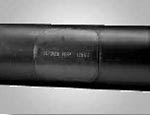In the case of Covalence (formerly Raychem) heat shrink sleeves, the answer is 'Crosslinking through Radiation Chemistry'. There are other (inferior) methods of crosslinking polyethylene, but I will cover those in a future post.
What follows is a more technical explanation than just about anyone could ever need, but here at Joint Specialists, we believe in teaching whenever possible, so here goes:
Once upon a time, it was discovered that the exposure of some plastic materials to high energy penetrating radiation can, in some cases, cause the permanent crosslinking, or intermolecular joining, of adjacent molecules. This crosslinking results in the chemical bonding of the plastic structure into a new three dimensional network. In addition, those plastics also no longer 'melt' as a typical plastic will AND those plastics gain a superior level of abrasion resistance over non-crosslinked materials.
 |
| Thermoplastic materials on a molecular level |
Thermoplastic materials are composed of extremely long, very thin molecules in a random arrangement. The strength of such materials depends upon the distance between its molecules, and the crystalline nature of its molecular structure. The above figure schematically illustrates the molecular structure of a thermoplastic material. The crystals formed where the molecules come close together are represented by dots. It is these crystals which provide more of the strength of the material. As the material is heated, these crystals disappear. The molecules can then slip past each other easily and the material flows. While in this heated condition, the material may be formed into almost any desired shape. Then, when the material subsequently is allowed to cool, the crystals reform and again provide substantial strength to retain the plastic in the shape in which it has been formed.
 |
| Thermoplastic material on a molecular level after crosslinking |
|
|
This figure illustrates the molecular structure of such a system after exposure to radiation, with the crosslinks shown as heavy read lines. Once the material has been crosslinked, it will not flow at any temperature. When the material is heated, the crystals still disappear as before, but it will no longer flow or change shape because the crosslinks act as ties between the molecules. The crosslinked structure, however, is elastic. Thus, when it is heated to a temperature where the crystals have melted, the material behaves like a rubber.
The unique heat-shrinkable properties of Covalence (and Raychem) products result from the exposure of a special thermoplastic formulations to radiation. Because of the resulting crosslinking, Covalence products have perfect elastic memory. These products are supplied in a deformed or expanded condition. When heated, they will shrink and tightly cover the object over which they have been placed. They are ideal for covering a variety of pipeline, electrical, and electronics components.
 |
| Enlarged schematic view of a very small crosslinked section of extremely long molecules |
|
|
Once the tubing has been crosslinked, the next step in imparting elastic memory is to heat the compound above its crystalline melting point. The molecules are then tied together only by the crosslinks as shown below.
 |
| Molecule currently heated above its crystalline melt point |
|
While hot, the tubing is deformed by applying pressure, thus stretching the crosslinked molecule (see below).
 |
| Tubing is expanded / stretched |
While in this deformed position, the tubing is cooled; the crystals then reappear, thereby locking the structure together in this deformed condition indefinitely. This is the form in which Covalence and Raychem products are supplied to customers.
 |
| Shrink sleeve molecular structure as supplied |
 |
| Shrink sleeve molecular structure 'in melt' or - during installation |
The customer then heats the heat shrink sleeve, melting the crystals. The crosslinks allow the material to return to its original shape as shown above. This it the perfect elastic memory of heat shrink.
 |
| Upon cooling, crystals reform |
Upon subsequent reheating, no further change in shape will take place, unless mechanical force is applied.
And now, whether you are coating the field joint of a pipeline; sealing some some kind of electrical splice or coating ten miles of pipeline at a factory; thanks to radiation chemistry your substrate is now confidently "Sealed for Life!"










































